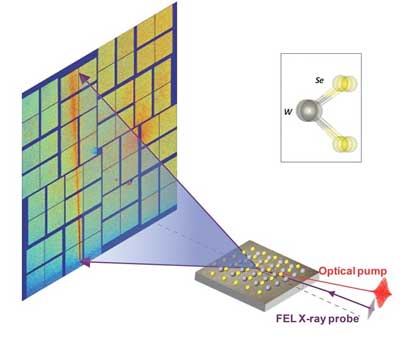| Jun 25, 2020 | |
Intense light pulses bounce on a crystalline bed without rumpling the atomic blanket(Nanowerk News) Scientists developed a new technique that uses intense X-ray pulses to measure how atoms move in a sheet of material just one molecule thick. This new ultrafast technique used pulses from the Linac Coherent Light Source X-ray laser to energize the electrons in a two-dimensional sheet. |
|
| Using this process, scientists showed that movement of the atoms in the tungsten-selenium “blanket” layer caused the layer to stretch but not wrinkle. This pattern held even after the atoms vibrated more than 100 cycles (Nature Photonics, "Anisotropic structural dynamics of monolayer crystals revealed by femtosecond surface X-ray scattering"). | |
 |
|
| An ultrafast X-ray probe scatters from a molecular sheet (grey and yellow) energized by laser light. A multi-element detector captures the scattered X-rays (purple), making a distinctive pattern that correlates with atoms’ positions and vibrations. (Image: Argonne National Lab) | |
| Ultrafast X-ray scattering helps scientists track changes in the crystalline structure of materials at the time scale of atomic vibrations. | |
| However, it is difficult to apply to 2-D materials. The new technique for measuring atomic motions in a one-molecule thick sheet enables scientists to track energy transfer and flow. | |
| The technique helps them understand the ultrafast changes that occur when materials are subject to increased levels of energy from light pulses. Scientists are especially interested in how energy transfers from light to electrons and on to atoms. This determines how novel arrangements of atoms can produce materials with new optical and electronic properties. | |
| As materials become smaller, and the properties of those materials increasingly depend on ultrafast movements of their atomic structures, scientists are expanding the ability of X-ray techniques from new laser sources to understand those structures. | |
| In this research, scientists used a laser to create an optical photon burst that essentially “jumps” on a crystalline solid-substrate bed that is covered by a tungsten-selenium atomic blanket only one layer thick. The blanket absorbs the light and transfers energy into electron states called “excitons.” | |
| The energy eventually merges into the motion of the atoms in the blanket and finally into the substrate as heat. This 2-D blanket material possesses unique optical and electronic properties that are potentially useful for electronic and light processing applications. | |
| To use these 2-D materials, researchers need information on how they absorb light and how energy flows, including atomic distortions on ultra-fast time scales. The new X-ray technique involved exciting the blanket using ultra-short pulses of laser light, then measuring the atomic positions over a series of specific time delays using pulses of X-rays. | |
| The X-rays were sensitive to movements within the plane of the blanket as well as movements away from the surface. The minimum time delay was short enough to capture motion faster than a complete vibration cycle. The research was conducted at the Linac Coherent Light Source, the nation’s premier X-ray free electron laser light source. | |
| The resulting data showed that rather than vibrate outside the blanket, the direction that would create rumples, the atoms remained in the plane, keeping the surface flat even while the atoms vibrated for more than 100 cycles around their initial positions. | |
| The result counters the expectation that atoms would move out of the plane because there is free space above the plane. The technique took advantage of the ability to pack, in a short time pulse and small surface space, enough X-rays to provide a significant scattering signal from an atomically thin cover layer. |
| Source: U.S. Department of Energy Office of Science | |
|
Subscribe to a free copy of one of our daily Nanowerk Newsletter Email Digests with a compilation of all of the day's news. |
